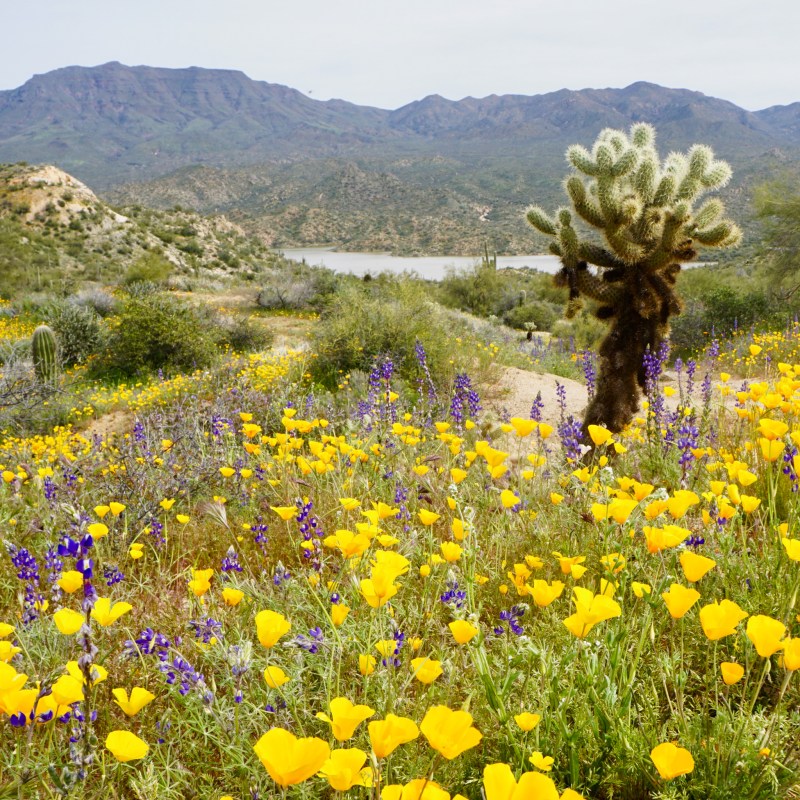
Cindy Barks
On the scale of things that universally make people happy, wildflowers are certainly up there — hovering somewhere between waterfalls and rainbows.
Videos by TravelAwaits
In the Arizona desert, where springtime ushers in wildflower season, there is plenty of delight to go around. Especially after a wet winter, the spiky and sometimes forbidding Sonoran Desert can become softened by endless fields of yellows, purples, and reds.
Thankfully, 2020 is one of those lucky years. While the spring flowers are perhaps not as plentiful as they were in 2019 — a truly remarkable year in the desert — they are still showing up in ample numbers.
The colorful flowers can be seen clustered along busy highways and interstates, but the best way to savor the bounty of Arizona’s wildflowers is to take a hike.
Wildflowers are not the only appeal of Arizona’s trails in the springtime. It is also the time when the desert climate is at its best for hiking the rugged terrain. The Phoenix area enjoys average high temperatures in the high 70s in March, the mid-80s in April, and into the 90s in May. Hiking is generally discouraged in Phoenix’s brutal summer heat, but late autumn and winter can also be great times to visit.
Of course, spring is also the time when the trails tend to be busiest, so it pays to seek out lesser-used trails. Here are five perfect Arizona wildflower hikes, a mix of off-the-beaten-path options and well-known spots.

Cindy Barks
1. Black Canyon National Recreation Trail, Black Canyon City
Showcasing some of the best of the wide-open Sonoran Desert, the Black Canyon National Recreation Trail runs 80 miles along a north-south route once used by prehistoric Native American travelers and traders.
For quick access to towering saguaro cacti and nonstop clusters of wildflowers, head to the Black Canyon City Trailhead, near the Interstate 17 outpost of Rock Springs. Walk south along the undulating single-track trail, and you’ll soon reach the middle of a cactus forest.
The trail surface is rocky and rough, but the grade is fairly gentle. An out-and-back hike of 3 to 4 miles will yield great views and a moderate workout. Along the way, you will be treated to regular stands of lavender lupine, purple owl clover, and numerous clusters of golden sunflower-like globe chamomile (albeit an invasive species).

Cindy Barks
Expect to spend about 2 hours on a 3-to-4-mile round trip. As with any hike in the desert, remember to wear sturdy hiking shoes and carry plenty of water. Even in the spring, the temperatures can soar into the 80s and 90s, and there is little shade along the route. Although you will encounter plenty of other hikers, I have found that the Black Canyon Trail is less busy than Phoenix’s popular Camelback Mountain and Piestewa Peak Trails.
Highlight: The trail runs along a ridge that opens up to spectacular views of the Agua Fria River that twists through the canyon below. The flow is somewhat seasonal, but in the spring, the Agua Fria is often full and robust. Long before you reach the pebbly banks of the river, you will hear that most beautiful of desert sounds — rushing water. On hot spring afternoons, families gather along the river’s banks, taking careful dips in the cool water.

2. Jojoba Trail, Bartlett Lake, Tonto National Forest
Known as one of the best places in the Phoenix area to spot delicate poppy blooms, Bartlett Lake is located in the Tonto National Forest about an hour northeast of Scottsdale.
One of the beauties of the Bartlett Lake wildflower scene is that the blooms are easily accessible along the paved roads that wind around the reservoir. Flower peepers often drive the scenic route and park alongside the road at spots like Rattlesnake Cove to photograph the fields of yellow-orange poppies.
It is not necessary to hike to see the best of Bartlett Lake’s wildflowers, but if you are in the mood for a fairly easy walk through the desert with the blue waters of the lake as a backdrop, head to Jojoba Trail. The 1.3-mile route stretches from Rattlesnake Cove to the Jojoba boating site, passing by flowering ocotillo cacti, tufts of poppies, and sweeping views of the rugged Mazatzal Mountains to the east. The 2.6-mile round trip should take about 1.5 hours to complete.
Remember that a Tonto Pass is needed to park at many of the developed sites around Bartlett Lake. The passes can be purchased at the Cave Creek Ranger Station near Cave Creek.
Highlight: The coves that dip deep into the desert terrain make secluded spots to view the wildflowers as well as the picturesque boating scene on Bartlett Lake.

Cindy Barks
3. Lime Kiln Trail, Dead Horse Ranch State Park, Cottonwood
For a truly remote high-desert experience, head to the Lime Kiln Trail in Dead Horse Ranch State Park, located in Cottonwood, about 1.5 hours north of Phoenix.
While the state park is popular for its lush riparian area along the Verde River, it is also the trailhead for the rugged Lime Kiln Trail. The 15-mile-long trail runs northeast toward Sedona and ends near the scenic Red Rock State Park.
The trail follows a historic route that dates to the 1880s, when it was built to serve a kiln that produced lime for the mortar used for construction of early homes in the area.
In the springtime and early summer, the otherwise desolate route comes alive with white daisies and blooming cacti.

Cindy Barks
Adventurous hikers or mountain bikers might want to try the entire 15-mile route. But for those who want only a taste of the Lime Kiln Trail, I suggest parking at Dead Horse Ranch State Park and hiking in for 2 to 3 miles for a round trip of 4 to 6 miles.
The trail is rough and steep in places and is rated as strenuous. Traffic is light, though, so you are likely to see few other hikers and bikers on the route.
Highlight: The trail passes by ancient cottonwood trees with glossy leaves and transitions quickly to desolate white cliffs that offer sweeping views of the Verde River Valley.

Cindy Barks
4. Wild Burro Trail, Lake Pleasant Regional Park, Morristown
Water and desert converge beautifully at Lake Pleasant, a regional park located about 45 minutes northwest of Phoenix. For the best of both, head to the Wild Burro Trail, a busy 3.1-mile trail that passes by saguaro and cholla cacti before ambling down to hug the lovely lake shoreline.
Along the way, the trail showcases some of the best of Arizona’s spring wildflower scene. Interspersed in the rocky terrain are pretty little stands of purple owl clover, complemented perfectly by the yellow chamomile flowers. In some places, the pink-purple flowers of the strawberry hedgehog cacti serve as centerpieces for the wildflowers.
The trail gets heavy traffic, especially on sunny spring weekends, so a weekday visit is recommended. Regardless, expect to encounter plenty of other hikers, as well as fishermen and campers clustered along the lake’s beautiful coves.

Cindy Barks
The terrain is rocky and rough, but the elevation gain is relatively minor, at just over 200 feet. Expect to spend 2 to 3 hours hiking the entire 3.1-mile route. I recommend packing a picnic lunch and stopping at one of the coves for a break.
A fee is required to enter Lake Pleasant Regional Park.
Highlight: The views of the lake — set off by saguaros and cholla cacti — are stellar along most of the route.

Cindy Barks
5. Siphon Draw Trail, Lost Dutchman State Park, Apache Junction
Arizona’s mining history is the main focus of Lost Dutchman State Park, but in the spring, wildflowers dominate the landscape.
Located in Apache Junction at the far eastern edge of Phoenix’s Valley of the Sun, the park was named after the fabled lost gold mine.
Walk along the popular Siphon Draw Trail, and you will be surrounded by yellow wildflowers that seem to stretch as far as the eye can see.
Although rated as difficult, the lower stretches of Siphon Draw are fairly easy and offer great vantage points to take in not just the wildflowers and plentiful flowering cacti, but the awe-inspiring backdrop of the Superstition Mountains as well.
I recommend walking as far as you feel comfortable on the 4-mile (round-trip) Siphon Draw Trail. The state park website describes the trail as a very scenic hike that winds into a canyon known as Siphon Draw. It is possible to continue on to the Flatiron, although the 5.8-mile round trip is not a designated trail, and it is known as one of the toughest hikes in the area.
“It’s advised that only experienced hikers in good shape attempt to hike to the top, as the climb is steep and difficult to follow,” says the park’s website, adding that the hike would take at least 5 hours to complete.
I recommend hiking up the first mile and a half or so of the Siphon Draw Trail, where you will be surrounded by wildflowers and be treated to a nonstop view of the Superstition Mountains.
Entry to the state park requires a fee.
Highlight: The rugged mountain view, set off by fields of wildflowers, is an iconic Arizona landscape.
